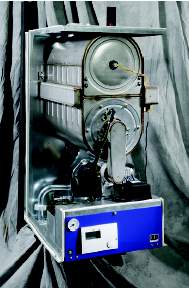New boilers for old radiators

The built-in weather-compensation capability of sophisticated condensing boilers make it possible to control return temperature at part load to benefit from energy-saving condensing operation.
Condensing boilers can be installed into existing heating systems without having to change the radiators. PETER GAMMON explains how.As the industry adjusts to the advent of the condensing-only era, attention in some quarters has focused on radiators and whether the changeover from a non-condensing to a condensing boiler may lead installers to increase the size of radiators to equal the heat output of the old system with the lower flow temperature from condensing boilers. Traditionally in the UK, LTHW heating systems have tended to be designed with an 11 K difference between flow and return temperatures (?T) of, typically, 82 and 71ºC. Domestic installations would typically have been operated at constant temperature and commercial installations at constant temperature or variable temperature (weather compensated).
Compensating control Installations with variable temperature would include a compensating controller and motorised mixing valve to blend down the fixed flow temperature of the boiler (usually 82ºC) to the requirements at the time as dictated by outside air temperature. Regardless of whether the flow temperature to the radiators is fixed or variable, the boiler operating temperatures remain more or less constant at around the original design temperatures To give best efficiency, a condensing boiler requires the water returning from a central heating system to be as cool as possible. To assist with this operational need, modern condensing boilers tend to be designed to operate with a ?T of 20 K. It is not economic in terms of equipment cost and extended payback periods to select radiators on the basis of operating at a 20 K ?T with design conditions that allow a return temperature below flue gas dewpoint all the time. (The dewpoint temperature of natural gas products of combustion is about 53ºC at 40% excess air in the combustion process). Also the enlarged size of the radiators needed would be prohibitive. Therefore when selecting radiators for use with a modern condensing boiler, consideration should be given to operating the system under design conditions at a flow temperature of 85ºC and a return temperature of 65ºC (20 K ?t). The mean water temperature is 75ºC under these conditions, almost the same as the 76.5°C mean temperature of the typical system operating at 82/71ºC.
Built-in compensation Therefore, radiator sizes do not change. A feature of modern condensing boilers such as the Strata and Ultramax Ranges from MHS Boilers is their ability to operate with direct-on-boiler weather-variable flow temperature (direct-on-boiler weather compensation). With a typical compensation slope applied, the return water will pass under the flue gas dewpoint temperature at an outside air temperature higher than about 3ºC. The end result is that with the same-size radiators, modern condensing boilers will operate with very high efficiency in condensing mode for most of the heating season, as most of the UK has a fairly mild climate, even in the depths of winter. The direct-on-boiler weather-compensation capability also means that variable temperature can be obtained without the extra expense and complications of installing mixing valves and the associated controls. When considering a boiler replacement and where the original boiler and system operated at a fixed 82/71ºC, a modern condensing boiler such as can be retrofitted to heat the existing radiators and the system re-commissioned to operate at 85/65ºC under design conditions. When the built-in weather compensation is activated, the payer of the gas bill can reap the considerable rewards of reduced fuel consumption, and the environment will enjoy significantly reduced emissions.
DHW If the boiler has a dual role of providing domestic hot water via an indirect cylinder or calorifier, the Strata boiler would deal with that need by elevating its flow temperature to design value and temporarily diverting its power to priority generation of hot water and then returning to providing heat to radiators once the hot-water demand is satisfied. This facility also allows the boiler to be sized according to the demand of the heating alone or the demand of the hot water alone — whichever is the greater, thus allowing a smaller boiler to be installed than would be the case if heating and hot-water loads were added to determine the boiler output. The message to installers and end users is select the right boiler and your existing radiators will work just fine.
Peter Gammon is technical products manager with MHS Boilers Plc, 35 Nobel Square, Burnt Mills Industrial Estate, Basildon, Essex SS13 1LT.
Related links:
Related articles:


